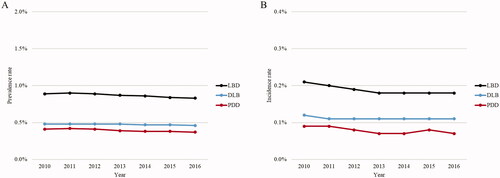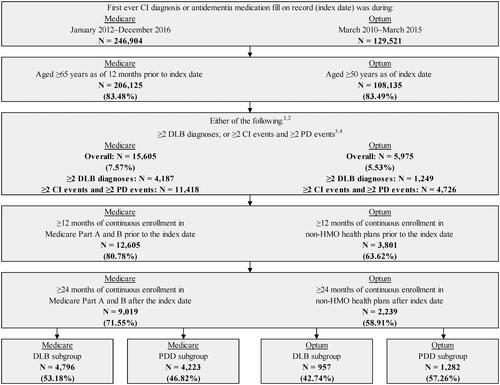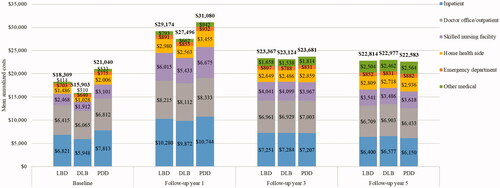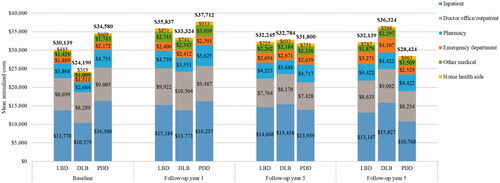Figures & data
Figure 1. PrevalenceCitation1–6 and incidenceCitation7 rates of LBD, DLB, and PDD in the Medicare population. Abbreviations: CI: Cognitive impairment; DLB: Dementia with Lewy bodies; LBD: Lewy body dementia; PDD: Parkinson’s disease dementia. Notes: 1Annual prevalence was estimated by dividing the number of prevalent LBD patients by the total number of patients in the eligible population of that calendar year. Prevalent LBD patients in a given calendar year were identified as the subset of patients who met the criteria for LBD based on all claims observed in the database, and whose index date was prior to or within the calendar year of interest.
2Patients were considered to have met all criteria of LBD if they had any of the following: 2 DLB diagnoses; or 1 DLB diagnosis, 1 non-DLB CI diagnosis, and 1 PD diagnosis; or 2 CI diagnoses and 2 PD diagnoses. 3Patients were considered to have DLB if their first-ever CI event was before or concurrent with the first-ever PD event on record. Their index date was the date of the first PD event. 4Patients were considered to have PDD if their first-ever CI event was after the first-ever PD event on record. Their index date was the date of the first CI event. 5CI events were defined as DLB diagnoses and non-DLB CI diagnoses. PD events were defined as DLB diagnoses and PD diagnoses. 6See Table S1 for ICD-9-CM and ICD-10-CM codes used to identify DLB, non-DLB CI, and PD diagnoses. Non-DLB CI diagnoses considered included mild cognitive impairment, memory loss, and dementia. 7Annual incidence was estimated by dividing the number of incident LBD patients by the total number of patients at risk in the eligible population of that calendar year. Incident LBD patients in a given calendar year were identified as the subset of patients who met all criteria for LBD based on all claims observed in the database, and whose index date was in the calendar year of interest.

Figure 2. Sample selection flowchart. Abbreviations. CI, cognitive impairment; DLB, dementia with Lewy bodies; GPI, generic product identifier; ICD-9-CM, International Classification of Diseases, Ninth Revision, Clinical Modification; ICD-10-CM, International Classification of Diseases, Tenth Revision, Clinical Modification; LBD, Lewy body dementia; PD, Parkinson's disease; PDD, Parkinson's disease dementia Notes: 1See Table S1 for ICD-9-CM and ICD-10-CM codes used to identify DLB, non-DLB CI, and PD diagnoses. Non-DLB CI diagnoses considered included mild cognitive impairment, memory loss, and dementia. 2Antidementia medications considered included memantine and cholinesterase inhibitors. 3CI events were defined as DLB diagnoses, non-DLB CI diagnoses, and anti-dementia medication fills. PD events were defined as DLB diagnoses, PD diagnoses and antiparkinson medication fills. Note that medication use was only evaluated in the commercial database, not the Medicare database. 4Patients with 1 DLB diagnosis were required to have the following: ≥1 non-DLB CI diagnosis or antidementia medication fill; ≥1 PD diagnosis or antiparkinson medication fill. Patients with no DLB diagnoses were required to have the following: ≥2 CI diagnoses; or ≥2 antidementia medication fills; or ≥1 CI diagnosis and ≥1 antidementia medication fill; ≥2 PD diagnoses; or ≥1 PD diagnosis and ≥1 antiparkinson medication fill.

Table 1. Baseline characteristics of the Medicare population.
Table 2. Baseline characteristics of the commercially-insured population.
Figure 3. Healthcare costs over time in the Medicare population. Abbreviations. DLB, Dementia with Lewy bodies; LBD, Lewy body dementia; PDD, Parkinson’s disease dementia.

Figure 4. Healthcare costs over time in the commercially-insured population. Abbreviations. DLB, Dementia with Lewy bodies; LBD, Lewy body dementia; PDD, Parkinson’s disease dementia.

LBD_claims_-_Supplementary_Tables.docx
Download MS Word (29.5 KB)Data availability statement
The datasets analyzed during the current study are not publicly available, as they are subject to a data use agreement between Analysis Group, Inc. and the Centers for Medicare & Medicaid Services and OptumHealth.
